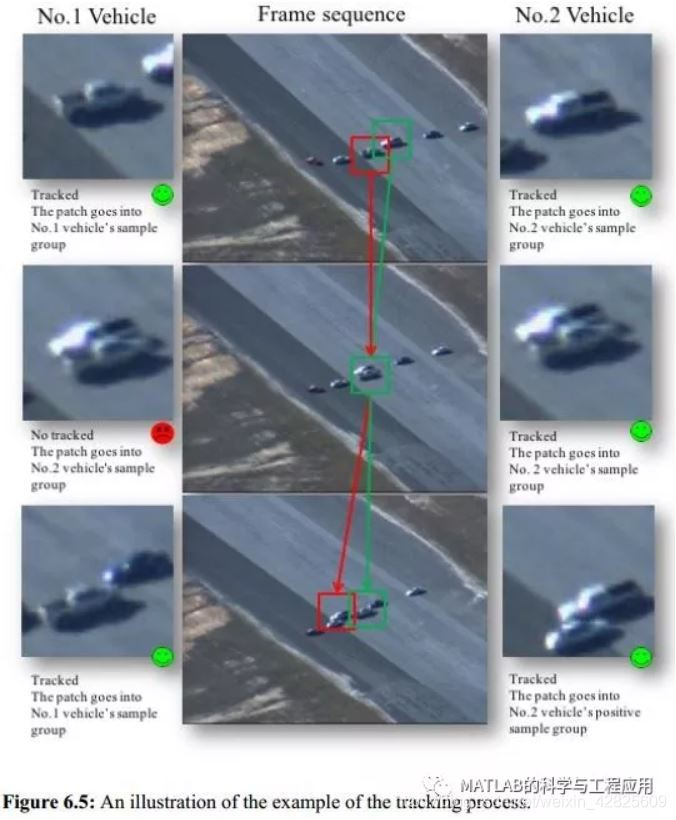【資訊科技】【2015.09】航空視訊中的車輛自動檢測與跟蹤

本文為英國拉夫堡大學(作者:XiyanChen)的博士論文,共194頁。
本文研究了航空視訊自動實時檢測和跟蹤的挑戰性任務。本文的目的是建立一個自動化系統,可以準確地定位出現在空中視訊中的任何車輛,並用跟蹤器跟蹤目標車輛。
車輛檢測與跟蹤有著廣泛的應用,近年來該課題一直是一個活躍的研究領域,然而,如何處理某些實際環境的情況仍然是一個挑戰。本文開發了車輛檢測與跟蹤演算法,增強了現有演算法檢測和跟蹤的魯棒性。本文提出的車輛檢測系統基於不同的目標分類方法,具有點模板和區域模板形式的顏色和紋理特徵。論文還提出了一種新的自學習跟蹤檢測方法,是對現有跟蹤學習檢測(TLD)演算法的擴充套件。檢測中最困難的挑戰是識別並聚類環境背景和噪聲中的目標車輛。在某些條件下,從無人機(UAV)捕獲的影象也是模糊的,例如,湍流會使飛行器在飛行期間發生抖動。本文通過應用整合多特徵描述來解決這些挑戰。
本文提出了三種車輛檢測方法:HSV-GLCM特徵檢測方法、ISM-SIFT特徵檢測方法和FAST-HoG特徵檢測方法。所使用的通用車輛檢測方法具有高度靈活的隱式形狀表示,它們基於正負集上的訓練樣本,並使用更新的分類器來區分目標。研究發現,HSV-GLCM紋理特徵的檢測結果會受到影象模糊問題的影響,本文所提出的檢測演算法可以進一步從背景中分割出車輛的邊緣。使用點描述特徵可以解決模糊問題,然而,點描述中包含的大量資訊可能導致實時處理的時間過長。因此,提出了一種結合點特徵和形狀特徵的FAST-HoG方法,這種新的方法能夠加快獲得實時效能的過程。最後,提出了一種利用FAST特徵的HoG檢測方法。HoG方法在物體識別中有著廣泛的應用,因為它具有很強的表示物體形狀向量的能力。然而,原始HoG特徵對目標方位敏感,本文的方法通過插入目標的方向向量對演算法進行改進。
針對目標跟蹤過程,提出了一種跟蹤多目標的新的TLD擴充套件演算法。原來的演算法只能跟蹤單個目標,必須在檢測和跟蹤過程之前進行選擇,新擴充套件的演算法對此進行了升級。車輛跟蹤面臨的最大挑戰是長時間跟蹤。目標物件在跟蹤過程中可能會改變其外觀,並且也可能發生光照和尺度變化。原始TLD特徵假設跟蹤過程會產生誤差,這些誤差的累積會導致跟蹤失敗,因此原始TLD在跟蹤和檢測之間通過新增一對檢查器(正負檢測)不斷地估計誤差變化。本文采用一種新的檢測方法來擴充套件TLD方法,以實現多目標跟蹤;提出了一種前向後向跟蹤方法來消除跟蹤誤差及遮擋等問題。本文提出的跟蹤系統的主要目的是在跟蹤過程中學習目標的特徵,並重新訓練檢測分類器以進一步處理。
本文重點研究了擁擠高速公路上、模糊影象和目標外觀變化等極端情況下的車輛檢測與跟蹤。與當前已有的檢測和跟蹤方法相比,所提出的方法在每個場景中都顯示了演算法精度的穩定提高。
This thesis isconcerned with the challenging tasks of automatic and real-time vehicledetection and tracking from aerial video. The aim of this thesis is to build anautomatic system that can accurately localise any vehicles that appear inaerial video frames and track the target vehicles with trackers. Vehicledetection and tracking have many applications and this has been an active areaof research during recent years; however, it is still a challenge to deal withcertain realistic environments. This thesis develops vehicle detection andtracking algorithms which enhance the robustness of detection and trackingbeyond the existing approaches. The basis of the vehicle detection systemproposed in this thesis has different object categorisation approaches, withcolour and texture features in both point and area template forms. The thesisalso proposes a novel Self-Learning Tracking and Detection approach, which isan extension to the existing Tracking Learning Detection (TLD) algorithm. Thereare a number of challenges in vehicle detection and tracking. The mostdifficult challenge of detection is distinguishing and clustering the targetvehicle from the background objects and noises. Under certain conditions, theimages captured from Unmanned Aerial Vehicles (UAVs) are also blurred; forexample, turbulence may make the vehicle shake during flight. This thesis tacklesthese challenges by applying integrated multiple feature descriptors forreal-time processing. In this thesis, three vehicle detection approaches areproposed: the HSV-GLCM feature approach, the ISM-SIFT feature approach and theFAST-HoG approach. The general vehicle detection approaches used have highlyflexible implicit shape representations. They are based on training samples inboth positive and negative sets and use updated classifiers to distinguish thetargets. It has been found that the detection results attained by usingHSV-GLCM texture features can be affected by blurring problems; the proposeddetection algorithms can further segment the edges of the vehicles from thebackground. Using the point descriptor feature can solve the blurring problem,however, the large amount of information contained in point descriptors canlead to processing times that are too long for real-time applications. So theFAST-HoG approach combining the point feature and the shape feature isproposed. This new approach is able to speed up the process that attains thereal-time performance. Finally, a detection approach using HoG with the FASTfeature is also proposed. The HoG approach is widely used in objectrecognition, as it has a strong ability to represent the shape vector of theobject. However, the original HoG feature is sensitive to the orientation ofthe target; this method improves the algorithm by inserting the directionvectors of the targets. For the tracking process, a novel tracking approach wasproposed, an extension of the TLD algorithm, in order to track multipletargets. The extended approach upgrades the original system, which can onlytrack a single target, which must be selected before the detection and trackingprocess. The greatest challenge to vehicle tracking is long-term tracking. Thetarget object can change its appearance during the process and illumination andscale changes can also occur. The original TLD feature assumed that trackingcan make errors during the tracking process, and the accumulation of theseerrors could cause tracking failure, so the original TLD proposed using alearning approach in between the tracking and the detection by adding a pair ofinspectors (positive and negative) to constantly estimate errors. This thesisextends the TLD approach with a new detection method in order to achievemultiple-target tracking. A Forward and Backward Tracking approach has beenproposed to eliminate tracking errors and other problems such as occlusion. Themain purpose of the proposed tracking system is to learn the features of thetargets during tracking and re-train the detection classifier for furtherprocesses. This thesis puts particular emphasis on vehicle detection andtracking in different extreme scenarios such as crowed highway vehicledetection, blurred images and changes in the appearance of the targets. Comparedwith currently existing detection and tracking approaches, the proposedapproaches demonstrate a robust increase in accuracy in each scenario.
1 引言
2 相關工作
3 模糊消除的HSV-GLCM特徵
4 採用SIFT的隱式形狀模型檢測演算法
5 本文提出的FAST和HoG檢測系統
6 本文提出的自學習跟蹤檢測演算法
7 結論與未來工作展望
附錄 測試視訊的部分結果
下載英文原文地址:
http://page5.dfpan.com/fs/0lcj522142917660082/
更多精彩文章請關注微訊號:
